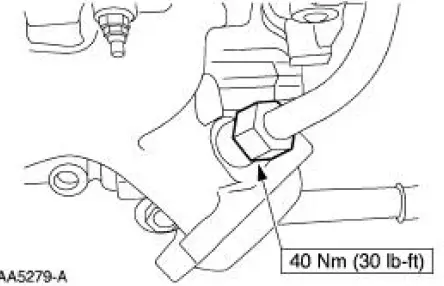Ford Mustang (1999-2004) Service Manual: Exhaust Manifold to Exhaust Gas Recirculation (EGR) Valve Tube - Cobra
Removal and Installation
1. Remove the EGR valve. For addditional information, refer to Exhaust Gas Recirculation (EGR) Valve-Cobra in this section.
2. With the vehicle in NEUTRAL, position it on a hoist.
3. Disconnect the exhaust manifold to EGR valve tube.

4. Remove the exhaust manifold to EGR tube from the engine compartment.
5. To install, reverse the removal procedure.
 Exhaust Manifold to Exhaust Gas Recirculation (EGR)
Valve Tube
Exhaust Manifold to Exhaust Gas Recirculation (EGR)
Valve Tube
Removal and Installation
NOTE: 3.8L shown, 4.6L (2V) similar.
1. With the vehicle in NEUTRAL, position it on a hoist.
2. Disconnect the exhaust gas recirculation (EGR) valve tube from the
exhaus ...
 Exhaust Manifold to Exhaust Gas Recirculation (EGR)
Valve Tube - Mach I
Exhaust Manifold to Exhaust Gas Recirculation (EGR)
Valve Tube - Mach I
Removal
1. Remove the air intake scoop. For additional information, refer to
Section.
2. Disconnect the exhaust gas recirculation (EGR) tube from the EGR valve.
3. With the vehicle in NEUTRAL, ...
Other materials:
Spindle
Special Tool(s)
Tie-Rod End Remover
211-001 (TOOL-3290-D) or
Equivalent
Removal
CAUTION: Suspension fasteners are critical parts because they affect
performance of vital
components and systems and their failure can result in major service expen ...
Engine (Installation)
Special Tool(s)
Lifting Bracket, Engine
303-D087 (D93P-6001-A1)
Lifting Bracket, Engine
303-D088 (D93P-6001-A2)
Installer Set, Teflon Seal
211-D027 (D90P-3517A) or
equivalent
Spreader Bar
303-D089 (D9 ...
Transmission Fluid Cooler
CAUTION: Whenever a transmission has been disassembled to install
new parts, the
cooler bypass valve (CBV), all transmission fluid coolers (in tank and
auxiliary) and
transmission fluid cooler lines must be cleaned and backflushed. Use a
suitable the t ...
